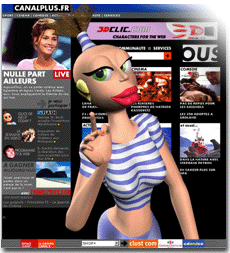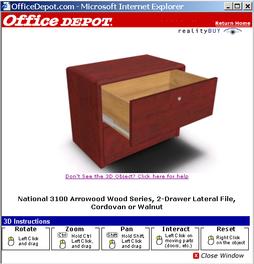
I've come across a few interesting new Web3D technologies and one
interesting real-life useful example. First have a look at some very cool facial technology
from a company called LifeFx. They've been in the business of capturing, in great detail,
the subtle movements of a face for many year.
Aside from simple motion capture their models are driven via a biologically based model. I'd
This mean that they claim to have models of muscles and skin and so on. Normally I'd dismiss this
claim with a yeah sure sure. However after looking at the people involved with this company,
for example Ray Kurzweil is on the Board of Directors, these people are serious! They really
do drive the face via biological model. This has fabulous implications. You could create
medical applications and create highly realistic motion in an efficient way.
While I do believe that the underlying technology is truly wonderful the initial application
"facemail" is quite hohum. It's about the third example of "let's send email with a talking face"
I've seen. They have created a good implementation which upon installation creates a new icon
on the IE browser window a nice convenience. It's also true the face, you can pick from five, is quite realistic, but it's not really all that compelling and
the speach synthesis, while decent is obviously machine driven. In the future you will be able
to have your own face (of course). It's a cute example but I doubt
that it will revolutionize email.
The second interesting Web3D example is not just a face but the whole body. A moving dancing body
that is superimposed on top of the Web page, from a company called qedsoft. QEDsoft let's
you stream an animated figure on top of your Web site to introduce and point out
features of the site. One of the currently existing customers for this is CanalPlus.
They have a cartoon (voluptuous of course) figure called Cleo. Cleo bounces around
the Web page (speaking French) pointing out features of the site. It's a cool application and
I could see some real value to this as long as the delays aren't too long.

Last but not least is an interesting example on the use of Web3D from Office Depot. Just the other
day I received some junk mail from these folks at home, a typical catalog of Office Depot product. Right
there on the cover was a blurb that said "Introducing 3D Viewing" and there in the inside cover
of the catalog was a picture of their website with a 3D desk and an explanation of this 3D thing.
So I went to the web site and to my pleasant surprise there was NO hype and NO massive pushing of
3D technology. I browsed around for some desks and chairs and when I reached the final selection to actually
see the product I was presented with a button (not in all cases) for a 3D view.

The great thing about this was that 3D is being used for what it's good at, the display of a product.
You can move the cursor and sometimes labels would identify pieces of the product and sometimes stuff
like drawers and chair backs would animate. They used Viewpoint's technology (formerly Metastream) for
their 3D and it was very effective. It's a great example of using 3D to improve the customer's experience.
It WAS NOT 3D for it's own sake like most examples on the Web.
Well that about it for this week's installment. Send me ideas/suggestions of other things you'd like
to learn or other 3D things you've seen.




